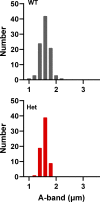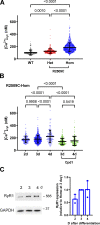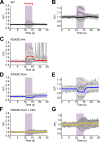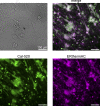Mice with R2509C-RYR1 mutation exhibit dysfunctional Ca2+ dynamics in primary skeletal myocytes
- PMID: 36200983
- PMCID: PMC9546722
- DOI: 10.1085/jgp.202213136
Mice with R2509C-RYR1 mutation exhibit dysfunctional Ca2+ dynamics in primary skeletal myocytes
Abstract
Type 1 ryanodine receptor (RYR1) is a Ca2+ release channel in the sarcoplasmic reticulum (SR) of the skeletal muscle and plays a critical role in excitation-contraction coupling. Mutations in RYR1 cause severe muscle diseases, such as malignant hyperthermia, a disorder of Ca2+-induced Ca2+ release (CICR) through RYR1 from the SR. We recently reported that volatile anesthetics induce malignant hyperthermia (MH)-like episodes through enhanced CICR in heterozygous R2509C-RYR1 mice. However, the characterization of Ca2+ dynamics has yet to be investigated in skeletal muscle cells from homozygous mice because these animals die in utero. In the present study, we generated primary cultured skeletal myocytes from R2509C-RYR1 mice. No differences in cellular morphology were detected between wild type (WT) and mutant myocytes. Spontaneous Ca2+ transients and cellular contractions occurred in WT and heterozygous myocytes, but not in homozygous myocytes. Electron microscopic observation revealed that the sarcomere length was shortened to ∼1.7 µm in homozygous myocytes, as compared to ∼2.2 and ∼2.3 µm in WT and heterozygous myocytes, respectively. Consistently, the resting intracellular Ca2+ concentration was higher in homozygous myocytes than in WT or heterozygous myocytes, which may be coupled with a reduced Ca2+ concentration in the SR. Finally, using infrared laser-based microheating, we found that heterozygous myocytes showed larger heat-induced Ca2+ transients than WT myocytes. Our findings suggest that the R2509C mutation in RYR1 causes dysfunctional Ca2+ dynamics in a mutant-gene dose-dependent manner in the skeletal muscles, in turn provoking MH-like episodes and embryonic lethality in heterozygous and homozygous mice, respectively.
© 2022 Tsuboi et al.
Figures













Similar articles
-
Comparison of Chlorantraniliprole and Flubendiamide Activity Toward Wild-Type and Malignant Hyperthermia-Susceptible Ryanodine Receptors and Heat Stress Intolerance.Toxicol Sci. 2019 Feb 1;167(2):509-523. doi: 10.1093/toxsci/kfy256. Toxicol Sci. 2019. PMID: 30329129 Free PMC article.
-
RyR1-mediated Ca2+-induced Ca2+ release plays a negligible role in excitation-contraction coupling of normal skeletal muscle.Proc Natl Acad Sci U S A. 2025 Aug 26;122(34):e2500449122. doi: 10.1073/pnas.2500449122. Epub 2025 Aug 21. Proc Natl Acad Sci U S A. 2025. PMID: 40838888
-
A malignant hyperthermia-inducing mutation in RYR1 (R163C): alterations in Ca2+ entry, release, and retrograde signaling to the DHPR.J Gen Physiol. 2010 Jun;135(6):619-28. doi: 10.1085/jgp.200910328. Epub 2010 May 17. J Gen Physiol. 2010. PMID: 20479110 Free PMC article.
-
Malignant hyperthermia and excitation-contraction coupling.Acta Physiol Scand. 2001 Mar;171(3):367-78. doi: 10.1046/j.1365-201x.2001.00840.x. Acta Physiol Scand. 2001. PMID: 11412150 Review.
-
Advances in malignant hyperthermia: novel insights into heat-induced Ca2+ release as a thermal signaling.J Smooth Muscle Res. 2025;61:65-74. doi: 10.1540/jsmr.61.65. J Smooth Muscle Res. 2025. PMID: 40903240 Review.
Cited by
-
Trans-scale thermal signaling in biological systems.J Biochem. 2023 Jul 31;174(3):217-225. doi: 10.1093/jb/mvad053. J Biochem. 2023. PMID: 37461189 Free PMC article. Review.
-
Research hotspots and trends in malignant hyperthermia due to anesthesia from a global perspective: a bibliometric analysis from 1975 to 2024.Orphanet J Rare Dis. 2025 Jul 1;20(1):325. doi: 10.1186/s13023-025-03766-5. Orphanet J Rare Dis. 2025. PMID: 40597248 Free PMC article.
References
-
- Boncompagni, S., Rossi A.E., Micaroni M., Hamilton S.L., Dirksen R.T., Franzini-Armstrong C., and Protasi F.. 2009. Characterization and temporal development of cores in a mouse model of malignant hyperthermia. Proc. Natl. Acad. Sci. USA. 106:21996–22001. 10.1073/pnas.0911496106 - DOI - PMC - PubMed
Publication types
MeSH terms
Substances
Grants and funding
LinkOut - more resources
Full Text Sources
Research Materials
Miscellaneous

